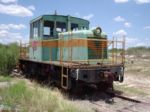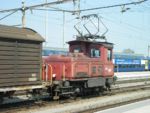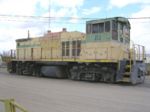Switcher
A switcher or shunter (Great Britain: shunter; USA: switcher, except Pennsylvania Railroad: shifter) is a small railroad locomotive intended not for moving trains over long distances but rather for assembling trains ready for a road locomotive to take over, disassembling a train that has been brought in, and generally moving railroad cars around - a process usually known as switching (UK: shunting). They do this in classification yards. Switchers may also make short transfer runs and even be the only motive power on branch lines.
The typical switcher is optimised for its job, being relatively low-powered but with a high starting tractive effort for getting heavy cars rolling quickly. Switchers are geared to produce high torque but are restricted to low top speeds and have small diameter driving wheels. Steam switchers are either tank locomotives or have special (smaller) tenders, with narrow coal bunkers and/or sloped tender decks to increase rearward visibility. Headlights, where carried, were mounted on both ends. Diesel switchers tend to have a high cab and often lower and/or narrower hoods (bonnets) containing the diesel engines, for all round visibility. Slugs are often used because they allow even greater tractive effort to be applied. Nearly all slugs used for switching are of the low hood, cabless variety. Good visibility in both directions is critical, because a switcher may be running in either direction; turning the locomotive is time-consuming. Some earlier diesel switchers used cow-calf configurations of two powered units in order to provide greater power. Now, the vast majority of switchers are diesels, but countries with near-total electrification, like Switzerland, use electric switchers. Small industrial shunters have sometimes been fireless locomotives and a few of these are still at work in Germany.
Switching is hard work, and heavily used switch engines wear out quickly from the abuse of constant hard contacts with cars and frequent starting and stopping.
British and European locomotives of this type tend to be much smaller than the common size in the United States. Current British shunters are Class 08 and Class 09.




